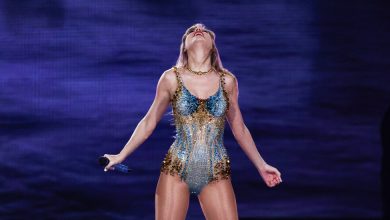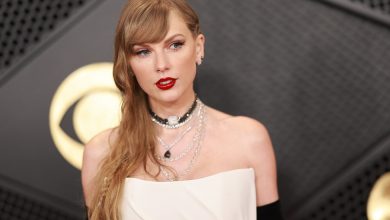Volodymyr Zelensky Is Playing the Role of His Life

Shortly after his surprise election as the president of Ukraine, Vasyl Petrovych Holoborodko gets a Pygmalion-like makeover and an introduction to his retinue of staff. There is his stylist. There is his psychologist. There is his “personal motivator.” And there is … himself?
An identical, slightly cross-eyed version of Holoborodko stands before him. It’s your body double, the prime minister explains. He’s available to appear at ceremonies, to meet with foreign dignitaries … or to take a sniper’s bullet. Of course, the prime minister adds, it probably won’t come to that.
Holoborodko is the character played by Volodymyr Zelensky in “Servant of the People,” the Ukrainian TV satire that debuted in 2015 and set up Mr. Zelensky, in 2019, to be elected president of Ukraine in real life. Since the Russian invasion, the series has been picked up to air in several countries; subtitled episodes are available on YouTube.
To watch it now is to experience, like Holoborodko, a chilling sense of double vision. There, on one screen, is Mr. Zelensky confronting the prospect of assassination for laughs. And there — on TV news, on monitors before world leaders and in his handmade videos from war-torn Kyiv — is the real man in real life, staring down real death.
Americans, of course, know a thing or two about electing presidents who have played leaders on TV. Reality does not always measure up to the prime-time myth. But as Mr. Zelensky has used his on-camera skill to rally his country and the world, he hasn’t just imitated his art. He’s improved on it.
More satirical than “The West Wing,” less caustic than “Veep,” with higher stakes than in “Parks and Recreation,” “Servant of the People” is a what-if fable about an ordinary citizen vaulted into power. Holoborodko, a history teacher, is caught on camera ranting about the country’s rampant corruption and cynicism. “I wish every common teacher lived like a president,” he storms. “I wish every president lived like a teacher, damn it!”
The video goes viral, and Holoborodko wins the election in a landslide. Suddenly he is a teacher living like a president, with all the job’s headaches. He has to contend with shadowy oligarchs and the International Monetary Fund, as well as the pedestrian forms of greed that seep into everyday life. (Holoborodko’s cabdriver father is intoxicated by the perks of presidential dad-hood, accepting “100 percent discounts” and turning his apartment into a mini Versailles.)
Much of “Servant” is broad and slapstick; in one scene, the president scampers Marx Brothers-style around the executive offices as a Swedish banker chases him for a loan repayment. As you might guess from the viral clips of a pre-political Mr. Zelensky winning the Ukrainian version of “Dancing With the Stars,” he’s a gifted physical comic. His beleaguered-nerd persona is a little Stephen Colbert, a little Steve Carell, a dash of Charlie Chaplin.
But “Servant of the People” is also stranger and more profound than its fish-out-of-water premise suggests. It’s insightful about the pressures on a fledgling democracy with more-powerful neighbors. While Russia is not central to the plot, consciousness of it is everywhere. Holoborodko’s trick for getting a raucous audience’s attention is to yell, “Putin has been overthrown!”
Ultimately, Mr. Zelensky’s show is an argument about the true source of political legitimacy. In its perhaps idealistic telling, power comes from being proximate to the people, not elevated above them. It comes not from being invincible but from knowing people’s precarity and sharing in their inconveniences. After his election, the new president continues living in his parents’ cramped flat.
Mr. Zelensky ran for president in a social-media-savvy campaign so tightly bound up with his fictional persona that his political party was also called “Servant of the People.” Like Holoborodko, he was, before the war, criticized as being in over his head.
But through the lens of his show, which argues that good leaders should share their citizens’ experiences, his response to the attack has seemed almost inevitable.
Shortly after the invasion, he released a video. Standing on a darkened street, capturing himself and a group of advisers in his phone’s lens, he speaks for half a minute.

CreditCredit…Ukrainian Presidential Office via Associated Press
The framing is intimate. The message is simple: “We are here.” The prime minister — here. The president — here. The soldiers — here. The repetition is potent, the defiance palpable. To citizens, foes and sympathetic Russians who were once fans of his show, it said, “We are not giving up our home.” To the world, it was David facing Goliath and picking up a digital slingshot.
Mr. Zelensky’s appearances throughout the war, from handmade videos to interviews, have had a similar personal feel. He wears fatigues, not a suit. This tells his people that he knows what they’re going through, and it reminds Western leaders that they can scarcely imagine what he’s going through. He opens a video from the presidential office selfie-style, shooting the street outside his window — again, I am here — then carrying you down the hall to his desk.
At a March 2 news conference, he sits next to the podium, instead of standing behind it. The Ukrainian people “elected me to have access to me,” he says. “You’re not a czar. You did not get this power from somebody up high.”
His videos present bravery as something both stirring and ordinary. He admits the possibility of death but says he does not want to die: “I don’t want Ukraine’s history to be a legend about 300 Spartans.” He’s not posturing as Rambo. If anything, he accentuates his vulnerability. He’s tired. He’s unshaven. Like Holoborodko, he puts himself forward as a manager, hired by Ukraine to do a job that Vladimir Putin just made that much lousier. He’s showing up for work.
Now he finds himself opposed to a larger world power, not only on the battlefield but also in the mediasphere, the one place where he has air superiority.
Over the decades, Mr. Putin has also played a character in the media, one that embodies very different ideas: strength and authority. They may not have had Charles Atlas ads in the Soviet Union that Mr. Putin grew up in, but his brand of machismo could have come straight out of them.
How the Ukraine War Is Affecting the Cultural World
Anna Netrebko. The superstar Russian soprano will no longer appear at the Metropolitan Opera this season or the next after failing to comply with the company’s demand that she distance herself from President Vladimir V. Putin of Russia in the aftermath of the invasion of Ukraine.
Vladimir Potanin. The Guggenheim Museum said that the Russian businessman and close associate of Mr. Putin would step down as one of its trustees, a position he took on in 2002. While no reason was given for the decision, the museum’s statement referenced the war in Ukraine.
Valery Gergiev. The star Russian maestro and vocal supporter of Mr. Putin was removed from his post as chief conductor of the Munich Philharmonic after he refused to denounce Russia’s actions in Ukraine. His abrupt dismissal came three years before his contract was set to expire.
Alexei Ratmansky. The choreographer, who grew up in Kyiv, was preparing a new ballet at the Bolshoi Theater in Moscow when the invasion began, and immediately decided to leave Moscow. The ballet, whose premiere was set for March 30, was postponed indefinitely.
Gérard Depardieu. The French actor, who became a Russian citizen in 2013 and is one of the closest Western celebrities to Mr. Putin, took a surprising stance when he denounced the war during an interview.
He has been photographed riding horseback, shirtless. (In contrast, the “Servant” credits have Holoborodko biking to work, a clothespin clipped to his trouser leg.) He has posed riding a motorcycle and doing judo and going spear fishing (again shirtless). In televised hockey exhibitions with government officials, he shoots goal after goal on an opposing team that puts up flimsy defense.
All this biceps-kissing, pump-you-up cosplay moved not only his domestic admirers but also some American conservatives, particularly during the Obama era. In 2014, the historian Victor Davis Hanson, writing in National Review, compared “bare-chested Putin,” who “gallops his horses, poses with his tigers and shoots his guns” with the “metrosexual golf get-ups” and “prissy poses” of the American president.
The pandemic, however, isolated and changed Mr. Putin, and his imagery changed with it. He was photographed alone in conference rooms. We saw him berating and bullying his cringing underlings in a televised meeting. Reportedly fearful of Covid, he took meetings at one end of a table so long it seemed to defy the laws of physics.
Maybe this was also an image of authority, but a different one. A strong leader, it said, is untouchable, inviolable, remote.
Ultimately, of course, Mr. Putin made himself a pariah not through his pictures but through his actions. Still, set-designing himself as a Bond villain hasn’t helped. It is a contest that Russia seems to know it is losing. Russia’s foreign minister, Sergey Lavrov, complained that his country was facing a “Hollywood” narrative of “absolute evil and absolute good.”
Mr. Zelensky is conscious of his opponent’s image, too, and willing to tweak it. In one appeal for peace, he called on Mr. Putin to negotiate with him face to face — “not at 30 meters.” In terms of image, at least, Mr. Zelensky has used the judo aficionado’s own weight against him.
Of course, memes can’t stop a cruise missile. Mr. Zelensky has said as much. “It’s not a movie,” he told CNN, asked about his shift from actor to leader. “I’m not iconic. I think Ukraine is iconic.”
But it’s no insult to say that performance is part of leadership. Rhetoric isn’t ammunition, but it can keep soldiers fighting and move the world to arm them. Mr. Zelensky’s dramatic speeches to European leaders helped galvanize the continent’s response and moved a translator to tears. His address to the British Parliament echoed Winston Churchill’s words as the Nazis advanced across Europe in 1940. “We will fight in the forests, in the fields, on the shores, in the streets,” Mr. Zelensky said, challenging Britain to see its own history in Ukraine’s dire moment.
Performance, be it on a TV set, in a campaign or from a bunker, is about giving shape to the abstract. In the case of Ukraine, Mr. Zelensky has personalized the struggle between liberal democracy and authoritarianism in the contrast between himself and Mr. Putin and pushed the world to choose a side.
Could a different leader have done this? We may never be able to prove whether a sitcom changed world history. But certainly Mr. Zelensky the performer has given Mr. Zelensky the president some of his most powerful weapons.



